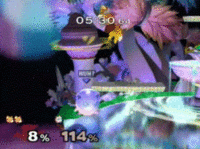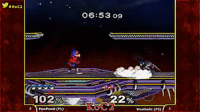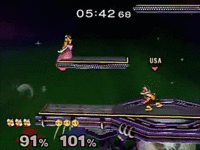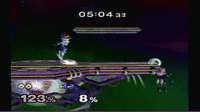Mindgame: Difference between revisions
Anthony1996 (talk | contribs) |
m (→Conditioning) |
||
| (22 intermediate revisions by 12 users not shown) | |||
| Line 8: | Line 8: | ||
[[File:Hard Read Fox Melee.gif|thumb|{{sm|Mango|c1=Fox|g=SSBM|size=12}} | [[File:Hard Read Fox Melee.gif|thumb|{{sm|Mango|c1=Fox|g=SSBM|size=12}} | ||
hard reading a [[roll]] from {{Sm|Hungrybox|c1=Jigglypuff|g=SSBM|size=12}}, thereafter KO'ing him with an up smash.]] | hard reading a [[roll]] from {{Sm|Hungrybox|c1=Jigglypuff|g=SSBM|size=12}}, thereafter KO'ing him with an up smash.]] | ||
Predicting an opponent's option is the most basic example of a mindgame. It involves observing an opponent's behaviour and discerning habitual patterns in their play-style, then predicting these actions and [[punish]]ing them. Successfully predicting a player's action is commonly referred to as a '''read''', and furthermore, there are two types of reads: a '''soft read''' and a '''hard read'''. The relationship between the types of reads is a matter of risk versus reward; a soft read occurs when a player punishes an opponent's options while covering other options (often resulting in sub-optimal punishment), whereas a hard read occurs when a player specifically reads a single option with its optimal punishment but at the expense of not covering other choices the opponent could have made. An example of a soft read would be covering [[tech]] options. For example, if an opponent is put into a tech chase, | Predicting an opponent's option is the most basic example of a mindgame. It involves observing an opponent's behaviour and discerning habitual patterns in their play-style, then predicting these actions and [[punish]]ing them. Successfully predicting a player's action is commonly referred to as a '''read''', and furthermore, there are two types of reads: a '''soft read''' and a '''hard read'''. The relationship between the types of reads is a matter of risk versus reward; a soft read occurs when a player punishes an opponent's options while covering other options (often resulting in sub-optimal punishment), whereas a hard read occurs when a player specifically reads a single option with its optimal punishment but at the expense of not covering other choices the opponent could have made. An example of a soft read would be covering [[tech]] options. For example, if an opponent is put into a tech chase, they only have four options: tech-rolling towards the player, tech-rolling away from the player, a neutral tech, or missing the tech on purpose. By dash dancing near the opponent, a player effectively covers three of the four options: the neutral tech, the missed tech, and the tech roll towards the player (since these three can be punished upon reaction). An example of a hard read would occur if, in the scenario described above, the player picked one tech option and charged a smash attack in the location the opponent would end up after picking that said tech option. Such an example of a hard read occurs in the GIF to the right. Another occasionally used term is a '''call-out'''. While it has been used interchangeably with hard read, it specifically is used in the context of a player being overconfident and the opponent exploiting their hubris by punishing what everyone believed to be a completely safe strategy. | ||
===Baiting=== | |||
[[File:PowershieldFsmash.gif|thumb|Bad laser spacing is a commonly baited habit in competitive play.]] | [[File:PowershieldFsmash.gif|thumb|Bad laser spacing is a commonly baited habit in competitive play.]] | ||
Another example of a mindgame is baiting, also known as luring, which is a slightly more complex form of predicting and punishing. It involves tricking an opponent into putting themselves in a vulnerable position. This is done by recognizing and remembering an opponent's reaction to a particular situation and inducing that situation in order to punish their reaction. In other words, this is punishing a player's habits. | Another example of a mindgame is '''baiting''', also known as '''luring''', which is a slightly more complex form of predicting and punishing. It involves tricking an opponent into putting themselves in a vulnerable position. This is done by recognizing and remembering an opponent's reaction to a particular situation and inducing that situation in order to punish their reaction. In other words, this is punishing a player's habits. | ||
An example of baiting commonly seen in competitive play is punishing laser habits from | An example of baiting commonly seen in competitive play is punishing laser habits from {{SSBM|Falco}} with powershielding. In ''Melee'', many Falco mains fire lasers recklessly, or only fire lasers from a specific distance. By memorizing the timing and spacing a Falco player fires lasers at frequently, one can move to that spot, read the laser, and prepare to [[powershield]] the laser and follow it up with a grab or an aerial. In the GIF to the right, such a laser was baited, powershielded, and punished with a wavedash out of shield into a forward smash. | ||
{{SSB4|Rosalina & Luma}} can bait opponents in a unique manner, as seen [https://www.youtube.com/watch?v=X8MRChI5_Pc here]. As Luma can still be controlled regardless of Rosalina's state, she can [[shield]] herself long enough to break her shield, baiting the opponent into attacking her while she is in a dazed state. Luma can then punish the opponent as the opponent comes to attack Rosalina. | {{SSB4|Rosalina & Luma}} can bait opponents in a unique manner, as seen [https://www.youtube.com/watch?v=X8MRChI5_Pc here]. As Luma can still be controlled regardless of Rosalina's state, she can [[shield]] herself long enough to break her shield, baiting the opponent into attacking her while she is in a dazed state. Luma can then punish the opponent as the opponent comes to attack Rosalina. | ||
====Pressuring==== | ====Pressuring==== | ||
[[File:MangoDD.gif|thumb|Here, | [[File:MangoDD.gif|thumb|Here, {{Sm|Mango|c1=Fox|g=SSBM|size=12}} uses dash dancing to pressure {{Sm|Armada|c1=Peach|g=SSBM|size=12}} into trying to take back stage control. Armada was pressured into trying to hit Mango out of the dash dance, but was unsuccessful and punished.]] | ||
[[File:ZhuPressure.gif|thumb|Here | [[File:ZhuPressure.gif|thumb|Here {{Sm|Zhu|c1=Falco|g=SSBM|size=12}} uses neutral aerial-shines to successfully pressure {{Sm|Mew2King|c1=Sheik|g=SSBM|size=12}} into doing a hasty shield grab.]] | ||
Pressuring is the act of limiting an opponent's options in order to force them to react. Like baiting, pressuring is used to lure out some sort of punishable action, but the difference is the action is lured out more aggressively and the opponent's habits are not necessarily taken into account. An option commonly used to pressure is dash dancing. Dash dancing (in conjunction with wavedashing) allows players to threaten an opponent while simultaneously taking safe space away from them. If done properly, the opponent will be forced to take a very risky action to counter the dash dancing such as trying to hit the dash dancing player or roll through it. An example of successful dash dance pressure is shown to the right. | '''Pressuring''' is the act of limiting an opponent's options in order to force them to react. Like baiting, pressuring is used to lure out some sort of punishable action, but the difference is the action is lured out more aggressively and the opponent's habits are not necessarily taken into account. An option commonly used to pressure is dash dancing. Dash dancing (in conjunction with wavedashing) allows players to threaten an opponent while simultaneously taking safe space away from them. If done properly, the opponent will be forced to take a very risky action to counter the dash dancing such as trying to hit the dash dancing player or roll through it. An example of successful dash dance pressure is shown to the right. | ||
The most famous pressure seen in competitive play though is shield pressure, particularly with | The most famous pressure seen in competitive play though is shield pressure, particularly with {{SSBM|Fox}} and {{SSBM|Falco}} in ''Melee''. They can use their shines and fast aerials to threaten a shielding opponent with a shield break, and thus force the opponent to try and escape the shield. With a few exceptions, most out of shield options are risky and have very explicit periods of vulnerability, meaning they can be punished very easily if read. Shield pressure is used to lure out one of the options to punish. An example of good shield pressure is shown in a GIF below. | ||
Another form of pressure involves attacking the opponent in ways where their options in response are extremely limited. This is known as a '''frame trap''', and involves leaving gaps between attacks that are shorter than the startup of the opponents fastest attack, meaning they will be punished unless they shield, run away, or use an [[armor]]ed attack, all of which can be accounted for and exploited. Frame traps require fairly extensive knowledge of frame data and how moves interact with each other, which makes them valuable at a high level of competitive play. | |||
Having difficulty dealing with pressure is a major weakness for some characters, such as [[Yoshi]], whose extremely limited [[OoS]] options without platforms and lack of reliable [[approach]] moves with considerable range gives him trouble against characters who can easily shield pressure him, and characters who can easily outrange his approaches (such as {{SSB|Kirby}} using his up tilt in ''Smash 64''). | |||
[[ | |||
==== | ====Conditioning==== | ||
A '''tomahawk''', also called an '''empty hop''', is a mindgame performed when a player nearby an opponent does a [[jump]], typically a [[short hop]], and simply lands back on the ground without using an attack. The intent is to make the opponent believe an aerial attack is coming and cause them to raise their [[shield]] (making the technique a bait). The jumper then has a free move on the shielding opponent, most commonly a [[grab]]. | '''Conditioning''' is about reinforcing an opponent's expectations and manipulating them into having a consistent response to the the same situation. This tactic is particularly effective against newer players, as they often don't have the mental fortitude to properly recognize this kind of behavior. There are two major types of conditioning that are commonly used. One method is to respond the exact same way to a given scenario, causing the opponent to believe this will happen every time. This method is called classical conditioning and is useful to catch an opponent off guard when a different outcome suddenly happens and they are left unprepared. Another method is to punish the opponent for repeatedly making the same bad decision to the point of them being hesitant to do it again. This method is called operant conditioning, and is effective at scaring the opponent into not using options that would theoretically be useful in the match. Learning to condition an opponent is often cited as the crucial step when going from a mid-level player to a high-level player. As such, it is extremely important to not only learn how to condition an opponent, but to also recognize when the opponent is also conditioning. | ||
This [https://www.youtube.com/watch?v=273tHua4wGc video] by [[Mew2King]] is a great resource for when learning how to condition an opponent. | |||
====Unexpected options==== | |||
[[File:Best Rest approach.gif|thumb|A Jigglypuff simply walking up to Sheik and using [[Rest]].]] | |||
Sometimes, situations occur where an opponent does not cover an option because it is known by both players to be inferior to other options, or is otherwise thought to be something "they would never do". Recognizing that the opponent doesn't expect something can make it notably more effective. A common example is Ike's forward smash; while it should generally never be used without a read or setup, successfully throwing it out when the opponent doesn't expect it can result in a surprise hit. | |||
Another type of unexpected option is known as a '''tomahawk'''. A tomahawk, also called an '''empty hop''', is a mindgame performed when a player nearby an opponent does a [[jump]], typically a [[short hop]], and simply lands back on the ground without using an attack. The intent is to make the opponent believe an aerial attack is coming and cause them to raise their [[shield]] (making the technique a bait). The jumper then has a free move on the shielding opponent, most commonly a [[grab]]. | |||
Being unexpected is very important in a [[ditto match]], as both players are using the same character, and thus likely already know the basic and optimal strategies. The only way to surprise the opponent is to just do things randomly to catch them off guard and use their confusion to quickly take the game. | |||
==See also== | ==See also== | ||
Revision as of 19:05, October 16, 2024
In the Super Smash Bros. series, mindgames are strategies or techniques employed for the purpose of outwitting opponents psychologically. Alongside technical skills, mindgames constitute players' play-styles, and are considered to be an important counterpart of technical skill in competitive play.
Examples
The following are types of mindgames that have been used, described and defined by the Smash community.
Predicting
Predicting an opponent's option is the most basic example of a mindgame. It involves observing an opponent's behaviour and discerning habitual patterns in their play-style, then predicting these actions and punishing them. Successfully predicting a player's action is commonly referred to as a read, and furthermore, there are two types of reads: a soft read and a hard read. The relationship between the types of reads is a matter of risk versus reward; a soft read occurs when a player punishes an opponent's options while covering other options (often resulting in sub-optimal punishment), whereas a hard read occurs when a player specifically reads a single option with its optimal punishment but at the expense of not covering other choices the opponent could have made. An example of a soft read would be covering tech options. For example, if an opponent is put into a tech chase, they only have four options: tech-rolling towards the player, tech-rolling away from the player, a neutral tech, or missing the tech on purpose. By dash dancing near the opponent, a player effectively covers three of the four options: the neutral tech, the missed tech, and the tech roll towards the player (since these three can be punished upon reaction). An example of a hard read would occur if, in the scenario described above, the player picked one tech option and charged a smash attack in the location the opponent would end up after picking that said tech option. Such an example of a hard read occurs in the GIF to the right. Another occasionally used term is a call-out. While it has been used interchangeably with hard read, it specifically is used in the context of a player being overconfident and the opponent exploiting their hubris by punishing what everyone believed to be a completely safe strategy.
Baiting
Another example of a mindgame is baiting, also known as luring, which is a slightly more complex form of predicting and punishing. It involves tricking an opponent into putting themselves in a vulnerable position. This is done by recognizing and remembering an opponent's reaction to a particular situation and inducing that situation in order to punish their reaction. In other words, this is punishing a player's habits.
An example of baiting commonly seen in competitive play is punishing laser habits from Falco with powershielding. In Melee, many Falco mains fire lasers recklessly, or only fire lasers from a specific distance. By memorizing the timing and spacing a Falco player fires lasers at frequently, one can move to that spot, read the laser, and prepare to powershield the laser and follow it up with a grab or an aerial. In the GIF to the right, such a laser was baited, powershielded, and punished with a wavedash out of shield into a forward smash.
Rosalina & Luma can bait opponents in a unique manner, as seen here. As Luma can still be controlled regardless of Rosalina's state, she can shield herself long enough to break her shield, baiting the opponent into attacking her while she is in a dazed state. Luma can then punish the opponent as the opponent comes to attack Rosalina.
Pressuring
Pressuring is the act of limiting an opponent's options in order to force them to react. Like baiting, pressuring is used to lure out some sort of punishable action, but the difference is the action is lured out more aggressively and the opponent's habits are not necessarily taken into account. An option commonly used to pressure is dash dancing. Dash dancing (in conjunction with wavedashing) allows players to threaten an opponent while simultaneously taking safe space away from them. If done properly, the opponent will be forced to take a very risky action to counter the dash dancing such as trying to hit the dash dancing player or roll through it. An example of successful dash dance pressure is shown to the right.
The most famous pressure seen in competitive play though is shield pressure, particularly with Fox and Falco in Melee. They can use their shines and fast aerials to threaten a shielding opponent with a shield break, and thus force the opponent to try and escape the shield. With a few exceptions, most out of shield options are risky and have very explicit periods of vulnerability, meaning they can be punished very easily if read. Shield pressure is used to lure out one of the options to punish. An example of good shield pressure is shown in a GIF below.
Another form of pressure involves attacking the opponent in ways where their options in response are extremely limited. This is known as a frame trap, and involves leaving gaps between attacks that are shorter than the startup of the opponents fastest attack, meaning they will be punished unless they shield, run away, or use an armored attack, all of which can be accounted for and exploited. Frame traps require fairly extensive knowledge of frame data and how moves interact with each other, which makes them valuable at a high level of competitive play.
Having difficulty dealing with pressure is a major weakness for some characters, such as Yoshi, whose extremely limited OoS options without platforms and lack of reliable approach moves with considerable range gives him trouble against characters who can easily shield pressure him, and characters who can easily outrange his approaches (such as Kirby using his up tilt in Smash 64).
Conditioning
Conditioning is about reinforcing an opponent's expectations and manipulating them into having a consistent response to the the same situation. This tactic is particularly effective against newer players, as they often don't have the mental fortitude to properly recognize this kind of behavior. There are two major types of conditioning that are commonly used. One method is to respond the exact same way to a given scenario, causing the opponent to believe this will happen every time. This method is called classical conditioning and is useful to catch an opponent off guard when a different outcome suddenly happens and they are left unprepared. Another method is to punish the opponent for repeatedly making the same bad decision to the point of them being hesitant to do it again. This method is called operant conditioning, and is effective at scaring the opponent into not using options that would theoretically be useful in the match. Learning to condition an opponent is often cited as the crucial step when going from a mid-level player to a high-level player. As such, it is extremely important to not only learn how to condition an opponent, but to also recognize when the opponent is also conditioning.
This video by Mew2King is a great resource for when learning how to condition an opponent.
Unexpected options
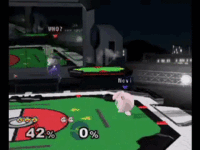
Sometimes, situations occur where an opponent does not cover an option because it is known by both players to be inferior to other options, or is otherwise thought to be something "they would never do". Recognizing that the opponent doesn't expect something can make it notably more effective. A common example is Ike's forward smash; while it should generally never be used without a read or setup, successfully throwing it out when the opponent doesn't expect it can result in a surprise hit.
Another type of unexpected option is known as a tomahawk. A tomahawk, also called an empty hop, is a mindgame performed when a player nearby an opponent does a jump, typically a short hop, and simply lands back on the ground without using an attack. The intent is to make the opponent believe an aerial attack is coming and cause them to raise their shield (making the technique a bait). The jumper then has a free move on the shielding opponent, most commonly a grab.
Being unexpected is very important in a ditto match, as both players are using the same character, and thus likely already know the basic and optimal strategies. The only way to surprise the opponent is to just do things randomly to catch them off guard and use their confusion to quickly take the game.
